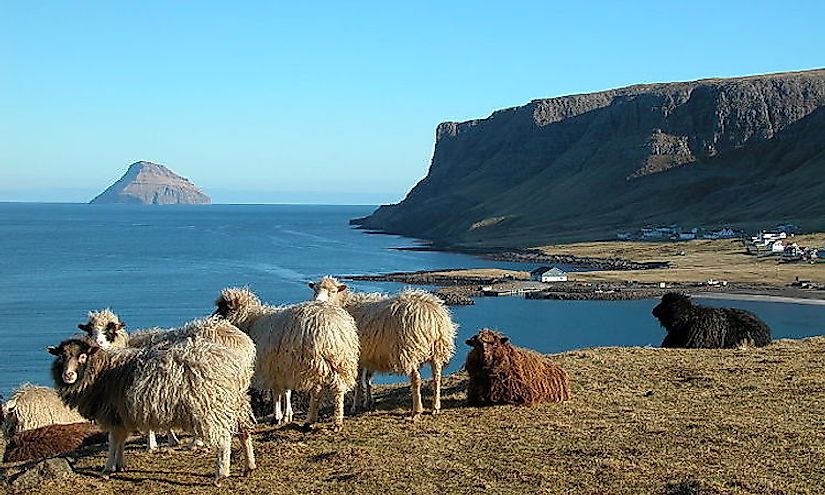The Largest Islands Of The Faroe Islands

The Faroe Archipelago is made up of a group of islands located between the North Atlantic and the Norwegian Sea which is about halfway between Iceland and Norway. The Faroe Islands is a sovereign country in the Kingdom of Denmark. The land around the archipelago is weathered with a subpolar oceanic climate.
Where Are The Faroe Islands?
18 islands constitute the Faroe Islands of which all are populated except Litla Dimun, the only one uninhabited. In Danish, the word Faroe may be a reflection of the word Old Norse which means sheep thus translating to the ‘islands of sheep.' The Faroe Islands used to be part of the Hereditary Kingdom of Norway from 1035 until the Treaty of Kiel in 1814 which granted Denmark authority over the archipelago along with Iceland and Greenland which were also Norwegian regions. Since 1948 the Faroe Islands have been an autonomous country within the Kingdom of Denmark. The Faroese have dominion over most of their domestic issues apart from justice, currency, foreign affairs, and military defense which are still a responsibility of Denmark. However, the Faroe Islands have an independent trade policy and are not part of the same custom area with Denmark. They can establish a trade agreement with other countries.
The Geography Of The Faroe Islands
The Faroe Islands are an archipelago comprising of 18 preeminent islands approximately 407 miles from the coast of Northern Europe. The islands are located between the North Atlantic Ocean and the Norwegian Sea which is centrally situated between Iceland and Norway. The Faroe Islands are bordered by the Outer Hebrides of Scotland and the Northern Isles. The archipelago stretches over an area of about 1,399 square kilometers and consists of small rivers and lakes. The islands have a rocky and rugged structure dominated by tholeiitic basalt lava, and whose elevation reaches 882 meters above sea level.
The Biggest And Smallest Islands By Size
Streymoy is the biggest island in the archipelago covering an area of approximately 373.5 square kilometers while Eysturoy is the second largest covering 286.3square kilometers. Litla Dimun is the smallest island in the archipelago stretching over an area of about 0.8 square kilometers and Koltur is the second smallest covering 2.5 square kilometers.
The Biggest And Smallest Islands By Population
The biggest island by population in the archipelago is Streymoy with an estimated population of 22,450 people followed by Eysturoy with a population of 10,726 people. The smallest island by population is Litla Dimun which is currently uninhabited while Koltur has one inhabitant.
Demographics Of The Islands Of The Faroe Islands
The earliest inhabitants of the Faroe Islands are believed to have been the Irish monks who lived in small settlements. Later on, the population in the islands increased following the Vikings’ colonial era. During this time the population never surpassed 5,000 people until the 19th century. In 1349 about half of the archipelago’s population died due to the Black Death plague. Urbanization and industrialization helped widen the demographics of the Faroe Islands which spreads across most of the area.
According to the 2011 census, the islands of Faroe had an approximate population of 48,600 inhabitants. 17,441 were private households while 43,135 were born in the archipelago, 3597 were either born in Denmark or Greenland, and 1,614 were born outside of Denmark. About 97% of the population comprising of children under the age of 15 claimed to be ethnic Faroese while 3% of 15 years claimed not to be Faroese. The islands of Faroe consist of people originating 77 different countries. The islands are becoming less regarded as separate entities and regions due to the massive investment on roads, bridges and sea tunnels that interconnect the whole archipelago together.
The Largest Islands Of The Faroe Islands
| Rank | Name Of The Island | Area [km²] | Population |
|---|---|---|---|
| 1 | Streymoy | 373.5 | 22,450 |
| 2 | Eysturoy | 286.3 | 10,726 |
| 3 | Vágar | 177.6 | 3,064 |
| 4 | Suðuroy | 166.0 | 4,680 |
| 5 | Sandoy | 112.1 | 1,283 |
| 6 | Borðoy | 95.0 | 4,940 |
| 7 | Viðoy | 41.0 | 596 |
| 8 | Kunoy | 35.5 | 129 |
| 9 | Kalsoy | 30.9 | 94 |
| 10 | Svínoy | 27.4 | 32 |
| 11 | Fugloy | 11.0 | 38 |
| 12 | Nólsoy | 10.3 | 235 |
| 13 | Mykines | 10.3 | 14 |
| 14 | Skúvoy | 10.0 | 36 |
| 15 | Hestur | 6.1 | 25 |
| 16 | Stóra Dímun | 2.7 | 8 |
| 17 | Koltur | 2.5 | 1 |
| 18 | Lítla Dímun | 0.8 | 0 |







